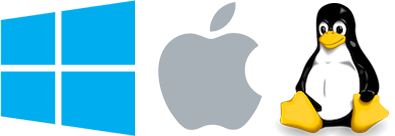Options
- USB 2.0 Cable
- Universal Mounting Bar
- Carrying Case
- ND Filters
Legend
- Included standard with meter
- Additional accessory (optional)
- Must be calibrated with the meter
Constructed using machined aluminium and stainless steel and weighs only 1 pound (450 grams).
Visbile + Near infrared spectrum (380 - 1080 nm) with a
spectral bandwidth of 8 nm
spectral resolution of 2 nm/pixel
spectral accuracy of ± 0.3 nm
The objective lens but can be customized when ordering. The 50 mm lens is the standard option (available at order time: 60 mm, 75 mm, 100 mm).
Designed for View Finders that are easily detachable and replaceble from the instrument's main body.
Luminance range of 0.34 Nits to 68,500 Nits (0.1 fL to 20,000 fL) (sensitivities measured for 10:1 signal to noise (RMS))

The ruggedly constructed housing of the CR-280-RH is made of machined aluminium and stainless steel, and can withstand high acceleration rates for the most demanding motion positioning systems and environments. All optical components are fixed to ensure that no optical misalignments occur due to vibration, shock or high acceleration/ deceleration rates.
It weighs only 1.0 pound (0.45 kg), and it is the perfect tool for display inspection and calibration and for mounting on fast moving XYZ tables. Its small size and shape allows for several CR-280-RHs to be mounted in the same motion control system and the simultaneous measurement of several spots in the same display.
The CR-280-RH is a USB 2.0 compatible device, remotely controlled by the host software from any personal computer, laptop or net book. As an option, the CR-280-RH can also be controlled by an Ethernet 10BASET/100BASE-TX IEEE-802.3 compliant connection or a RS-232 port.
The CR-280-RH can be equipped with an optional External Trigger Port which enables remote measurement activation from either a push button, a peripheral device, or by hardware trigger signals to measure strobes/pulsed lights, and start/stop signals. This option is ideal for fast temporal events that need to be precisely synchronized for measurement or data capture.
Future proof your CR-280-RH with additional custom color matching functions.
The CR-280-RH allows uploading up to three sets of custom CMF’s. This “custom” CMF’s can be alternate standards proposed by different organizations, such us Judd-Voss 1978 or custom CMF’s a researcher may be working on.

The CRIApp application is a streamlined, cross-platform, user-centric application designed to perform all colorimetric - based analysis. It provides a familiar and consistent workspace no matter which platform you are in. The CR-280-RH comes standard with a built-in, easy-to-learn command interpreter, for users to quickly create their own dedicated software to perform specific measurement tasks or for inclusion in an Automated Test Environment.
In addition, a fully documented communication language with numerous real-world, sample templates are included as starting points for customers to build their own software tools using any of the current development environments.

All our instruments are calibrated using NIST traceable calibration standards at a color temperature of 2856 Kelvins.
This is a standard calibration method used by most spectroradiometer manufacturers. In addition to the NIST traceable calibration standards we take pride in having developed proprietary Calibration and Quality Assurance processes that require a laboratory grade scanning double monochromator and high accuracy filters of known transmittance and chromaticity.
Essentially, no other spectroradiometers are used during manufacturing and Q.A. because none of them are as accurate as a laboratory grade scanning double monochromator.
The CR-280-RH, when compared with most of the high end spectroradiometers in the market, has been found to be on par or to exceed in accuracy and performance.
The Colorimeter Utility is an accompanying tool that aids in updating, preserving and recovering the state of the instrument. It is also used to define a color correction based on the Four-Color Matrix Method Correction.
| Detector | CMOS image sensor, 512 pixels |
|---|---|
| Spectral Range | 380 - 1080 nm |
| Spectral Bandwidth | 8 nm |
| Spectral Accuracy | ± 0.3 nm |
| Spectral Resolution | 2 nm / pixel |
| Luminance Range | 0.34 Nits to 68,25 Nits (0.1 fL to 20000 fL)‡ |
| Luminance Accuracy | ±2 %Ω |
| Luminance Repeatability | ≤1%Ω |
| Chromaticity Accuracy | ± 0.0015 x, yΩ |
| Chromaticity Repeatability | 0.0005 x, yΩ |
| Polarization Error | ≤ 0.5 % |
| Digital Resolution | 16 bits |
| Objective Lens | 50 mm*, 60 mm, 75 mm, 100 mm |
| Custom Synchronization | 10 - 10000 Hz |
| Exposure Time Range | 0.04 to 30 seconds |
| Power Requirements | 5V, 120 mA (600 mW) via USB 2.0 |
| Interface | USB 2.0, Ethernet, RS-232 |
| Weight / Mass | 1.0 pounds (0.45 kg) |
| Working Distance (mm) | 50 mm Lens | 60 mm Lens | 75 mm Lens | 100 mm Lens |
|---|---|---|---|---|
| 0 | 20.0 | 24.0 | 30.0 | 40.0 |
| 100 | 22.6 | 26.2 | 31.7 | 41.3 |
| 200 | 25.2 | 28.3 | 33.5 | 42.6 |
| 500 | 33.0 | 34.84 | 38.7 | 46.5 |
| 1000 | 46.0 | 45.7 | 47.3 | 53.0 |
| 2000 | 72.0 | 67.3 | 64.7 | 66.0 |
| 3000 | 98.0 | 89.0 | 82.0 | 79.0 |
| 20 + 0.026x | 24 + 0.02166x | 30 + 0.01733x | 40 + 0.013x |